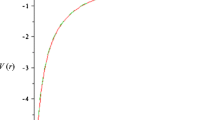Abstract
The WKB approximation is developed for the Dirac equation with the spherically symmetrical vector and scalar potentials. The relativistic wavefunctions are constructed, new quantization rule containing the spin-orbital interaction is obtained. For spherically symmetrical model of the Stark effect the quasi-classical spectrum of relativistic hydrogen-like atom is calculated. Application of the WKB method to the mass spectrum of the hydrogen-like quark systems was done.
Similar content being viewed by others
References
L.D. Landau and E.M. Lifshitz:Course of Theoretical Physics, Vol. 3,Quantum mechanics. Non-relativistic theory. Pergamon Press, London-Paris, 1958.
A.B. Migdal:Qualitative methods in quantum theory. Nauka, Moscow, 1975 (in Russian).
J. Heading:An introduction to phase-integral methods. Methuen, London, 1962.
N. Fröman and O. Fröman:JWKB Approximation. North-Holland Publishing Comp., Amsterdam, 1965.
Y. Yamabe, A. Tachibana, and H.J. Silverstone: Phys. Rev. A16 (1977) 877.
V.D. Mur and V.S. Popov: Zh. Eksp. Teor. Fiz.104 (1993) 2293.
I.V. Komarov, L.I. Ponomaryov, and S.Yu. Slavyanov:Spheroidal and Coulomb Spheroidal Functions. Nauka, Moscow, 1976 (in Russian).
B.M. Karnakov and V.P. Krainov:Quasiclassical approximation in quantum mechanics. MEPI Publishing, Moscow, 1992 (in Russian).
W. Pauli: Helv. Phys. Acta5 (1932) 179.
S.I. Rubinov and J.B. Keller: Phys. Rev.131 (1963) 2789.
J. Stachel and J. Plebansky: J. Math. Phys.18 (1977) 2368.
V.S. Popov: Pis. Zh. Eksp. Teor. Fiz.11 (1970) 254.
V.P. Krainov: Pis. Zh. Eksp. Teor. Fiz.13 (1971) 359.
M.S. Marinov and V.S. Popov: Zh. Eksp. Teor. Fiz.67 (1974) 1250.
J.B. Zel’dovich and V.S. Popov: Usp. Fiz. Nauk105 (1971) 403.
S. Mukherjee and S.S. Chandel: J. Phys. A11 (1978) 1257.
V.D. Mur and V.S. Popov: Yad. Fiz.28 (1978) 837.
V.D. Mur, V.S. Popov, Yu.A. Simonov, and V.P. Yurov: Zh. Eksp. Teor. Fiz.105 (1994) 3.
I.V. Dobrovolska and R.S. Tutik: Phys. Lett. A260 (1999) 10.
I.I. Haysak, V.I. Lengyel, and A.O. Shpenik: J. Phys. Stud.1 (1996) 42.
U. Muller-Nehler and G. Soff: Phys. Rep.246 (1994) 101.
A.B. Migdal:Fermions and bosons in strong fields. Nauka, Moscow, 1978 (in Russian).
A.A. Grib, S.G. Mamaev, and V.M. Mostapenko:Vacuum quantum effects in strong fields. Energoizdat, Moscow, 1988 (in Russian).
W. Greiner, B. Muller, and J. Rafelski:Quantum Electrodynamics of Strong Fields. Springer, Berlin, 1985.
Wen-Chao Qiang: Chinese Physics11 (2002) 757.
P.F. Byrd and M.D. Friedman:Handbook of elliptic integrals for engineers and scientists (2nd edn). Springer, Berlin, 1971.
Yu.A. Simonov: Yad. Fiz.60 (1997) 2252.
V.S. Popov, B.M. Karnakov, and V.D. Mur: Zh. Eksp. Teor. Fiz.113 (1998) 1579.
V.S. Popov and A.V. Sergeev: Zh. Eksp. Teor. Fiz.113 (1998) 2047.
R.Ya. Damburg and V.V. Kolosov:The theoretical investigation of behaviour of hydrogenous Ridberg atoms in electric fields. Salaspils, Riga, 1980 (in Russian).
J. Schwinger: Phys. Rev.82 (1951) 664.
C. Quiq and J. Rosner: Phys. Rep.56 (1979) 167.
W. Lucha, F. Schoeberl, and D. Gromes: Phys. Rep.200 (1991) 129.
S. Mukherejee, R. Nag, S. Sanyal, T. Mori, J. Morishita, and M. Tsuge: Phys. Rep.231 (1993) 201.
S. Deoghuria and S. Chakrabarty: J. Phys. G: Nucl. Part. Phys.16 (1990) 1825.
V.I. Lengyel, V.V. Rubish, and A.O. Shpenik: Ukr. Phys. J.47 (2002) 508.
V.I. Lengyel, V.V. Rubish, S. Chalupka, and M. Salak: Cond. Matt. Phys.1 (1998) 575.
M. Seetharaman, S. Raghavan, and S. Vasan: J. Phys. A16 (1983) 455.
Author information
Authors and Affiliations
Rights and permissions
About this article
Cite this article
Rubish, V.V., Lazur, V.Y., Reity, O.K. et al. The WKB method for the Dirac equation with the vector and scalar potentials. Czech J Phys 54, 897–919 (2004). https://doi.org/10.1023/B:CJOP.0000042643.47049.98
Received:
Revised:
Issue Date:
DOI: https://doi.org/10.1023/B:CJOP.0000042643.47049.98



